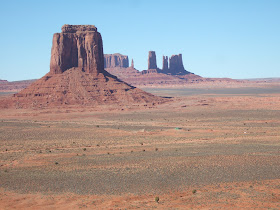I try to keep the geologic formations straight when venturing on the Colorado Plateau, but the smaller stuff is just as fascinating. Geology nuances that were not as noticed as much as on previous visits. I would note that my non geologists travelling companions generally could care less about the names of formations, but often appreciate an explanation of why things look the way they do.
One feature is the concept of a hard resistant rock formation forming steep spectacular cliffs with softer rock below protected by the cap rock.
The cap rocks are the very upper part of the mesa which are underlain by Shinarump Conglomerate of the Chinle Formation. The huge red cliffs are the De Chelly Sandstone of the Cutler Group. Below the sandstone is the softer Organ Rock Shale also of the Cutler Group.
The cap rock of Shinarump is not very thick at these mesas near Monument Valley, but is the critical protective layer. While the De Chelly Sandstone forms the scenic cliffs and is clearly capable of standing as steep vertical cliffs for very long periods, once the cliff face peals away and tumbles down the slope, the increased surface exposure makes quick work of the sandstone. Hence, there is very little talus apron of De Dhelly Sandstone at the base of these high cliffs.
Note the lack of talus below the cliff wall where sandstone blocks had previously fallen out of the cliff face. More recent rock falls to the left and right have not yet been turned into sand.
If not for the ready breakdown of the De Chelly Sandstone blocks from angular boulders to sand, the monuments of Monument Valley would not exist but instead would be mounds of talus with a low cliff near the top at most.
Note the near lack of talus blocks at the base of this monument.
The lack of talus also allows for ready viewing of the underlying Organ Rock Shale.
While the hard De Chelly Sandstone is readily turned to sand when surface area is increased post rock fall from the cliffs, some rock types are very resistant to erosion even with large surface exposure. The silica rich petrified forest logs in Petrified Forest National Park weather out of the soft mudstone of the Petrified Forest Member of the Chinle Formation, and in places form a resistant veneer of silica rich wood on the surface or as scattered logs laying on the ground surface after the surrounding mudstone as been completely eroded away.
Note log encased in mudstone on cliff face
Most of the red boulders below the cliffs are blocks and logs of petrified wood.







No comments:
Post a Comment